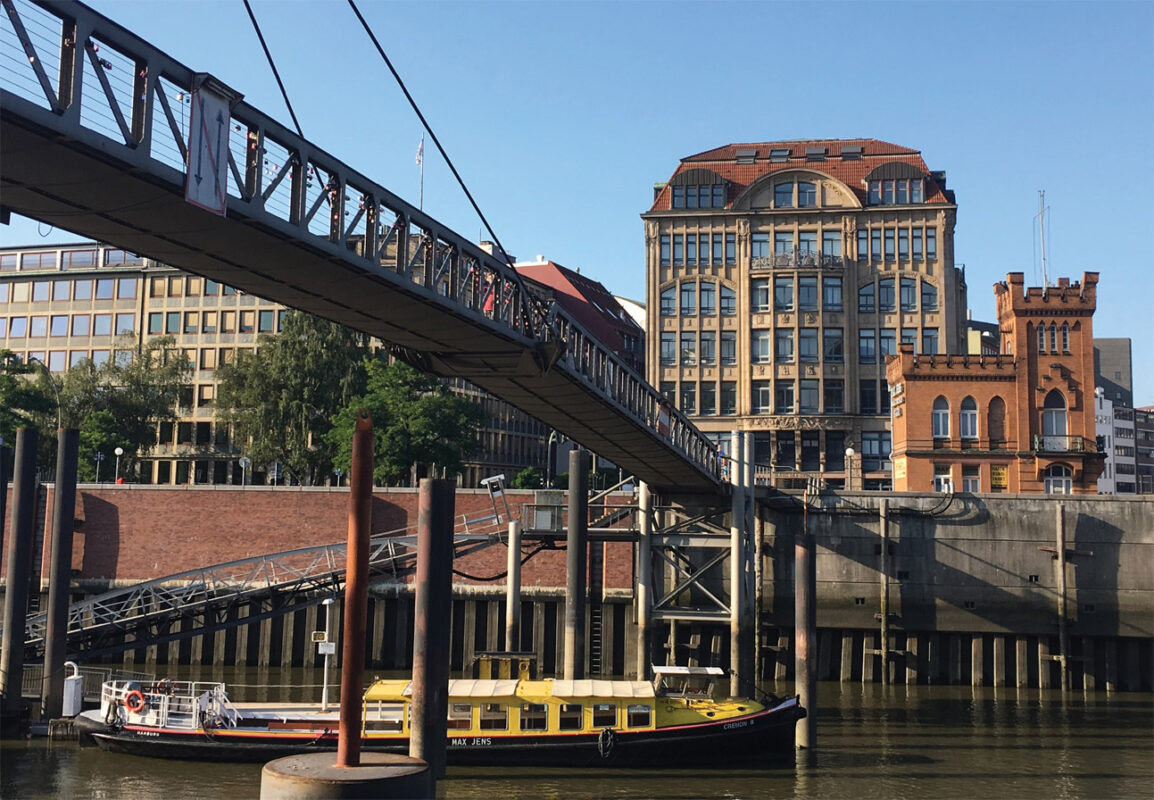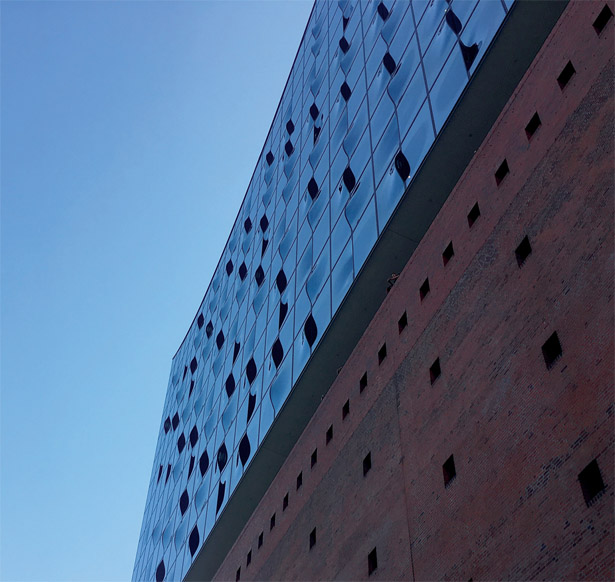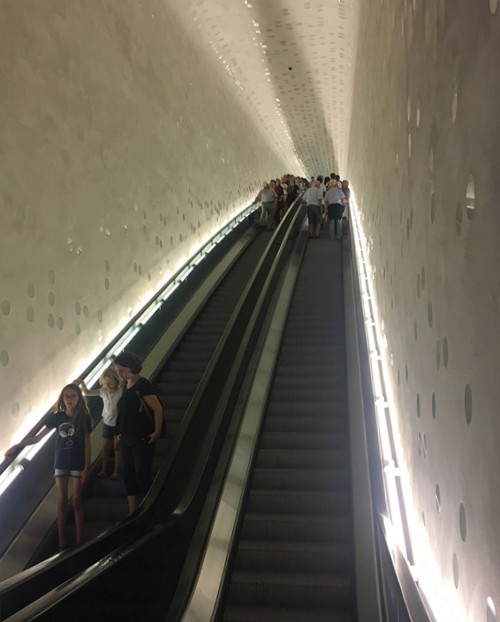White elephant
The Elbphilharmonie, an iconic edifice in Hamburg, is located on the banks of the River Elbe and was built on the foundations of the former Kaispeicher A, port grain warehouse, where cocoa beans were stored until the 1990s.
Text and photos: Paweł Kobylański
Hamburg is a city of special significance, strategically located on one of Europe’s most important rivers, which not so long ago marked the border between the political systems in the divided territory of Germany. Below Hamburg, the Elbe reaches a width of about half a kilometre and then widens further to become a 100 kilometre estuary, opening the waterway to the North Sea for even the largest ships. The port of Hamburg is the third largest in Europe (after Rotterdam and Antwerp), handling the equivalent of 9 million containers of cargo each year. The city is the second largest in Germany (after Berlin) and the eighth largest in the European Union, with a population currently approaching two million. Hamburg has always been a free city and an important centre of international trade. It became a member of the Hanseatic League in the Middle Ages and remained a sovereign city-state until the unification of Germany in 1871. Later, after the First World War, Hamburg briefly became a ‘ Civic Republic’, governed constitutionally by a council of prominent citizens. Despite the numerous disasters that have befallen the city throughout its history: fires, major floods caused by the “backflow” of North Sea water (the last of which occurred in 1962), and total wartime destruction as a result of massive Allied carpet bombing during the Second World War, Hamburg has always risen from the ruins to become even more powerful and even richer. Modern Hamburg is an economic powerhouse that is hard to grasp, and the headquarters of countless institutions and international corporations. This is reflected in the city’s extremely strong financial position, where things unimaginable elsewhere are becoming possible. The city is a dynamic investor in numerous public projects, thanks to which it is literally changing from day to day, transforming itself into an increasingly modern and environmentally friendly European metropolis. Former industrial sites and historic port infrastructure are being converted to serve new functions, while preserving the unique atmosphere of the former Free and Hanseatic City of Hamburg.
THE HAFENCITY HAMBURG
The most obvious focus of the city’s investment efforts is the new HafenCity district, which is being built on the site of the former port warehouses. With the decline in the economic importance of duty-free ports in the era of free trade within the European Union, and also as a result of the introduction of giant container ships, the area of Hamburg’s free port has been reduced and much of it has been freed from its former functions. The new plan, which was officially launched in 2008, also includes the historic Speicherstadt, which was added to the UNESCO World Heritage List four years ago, along with the neighbouring Kontorhaus quarter. HafenCity Hamburg is a bold project to revitalise the Grosser Grasbrook area, the former free port, with a wide range of investments that will create new urban functions: hotels, shops, restaurants, office and residential buildings. Covering an area of around 220 hectares, HafenCity is currently the largest urban regeneration project in Europe. When fully developed, it will be home to around 12,000 people and provide jobs for a further 40,000. There is no fixed completion date for the project, but it is likely to be between 2025 and 2030. The real jewel in HafenCity’s crown, however, is the Elbphilharmonie Concert Hall on the banks of the River Elbe – an iconic structure that dominates the entire district, built on the foundations of the former port grain warehouse Kaispeicher A. First built in 1875, it was named after Kaiser Wilhelm I. After the war, it was demolished and replaced in 1963 by the new Kaispeicher A, which was used to store cocoa beans until the 1990s. It was this building that served as the foundation for the new Hamburg Philharmonic. On a massive concrete base, an avant-garde structure has been erected with a glass façade that clearly refers to nautical forms: sails, sea waves and even icebergs. The façade is made up of 1,096 profiled glass elements, each weighing over a tonne and costing 20,000 euros per piece.
SPECTACULAR BUT EXPENSIVE
The Elphi project was born out of the somewhat crazy idea of Alexandre Gérard, a private developer and schoolmate of the Swiss starchitect duo Jacques Herzog and Pierre de Meuron. Gérard hoped to finance the entire cost of the philharmonic’s construction with the proceeds from the commercial sale of 45 exclusive flats and a 250-room hotel, which were also included in the development programme. He therefore commissioned his former schoolmates from Basel to create a spectacular alternative to the previously considered plan to build a rather bleak 90-metre-high office building on the site. The exciting vision of the Swiss architects instantly captivated the public and in 2003 the project was approved by the Hamburg city authorities and, perhaps even more importantly, recognised as a prestigious task of national importance. The final decision to build the philharmonic was taken in 2007 under Mayor Ole von Beust, who at the time also held the honoured position of chairman of the Bundesrat, the chamber of parliament representing the federal states of the Federal Republic. The investor was Elbphilharmonie Bau KG, whose main shareholder (and sponsor) was the City of Hamburg, which offered private investors significant incentives in the form of long-term tax breaks. Completion was originally scheduled for 2010, but the deadline was postponed several times, not least because of a year and a half-long freeze on public investment. Due to construction delays and the (more than elevenfold!) overrun of the originally estimated construction costs, the Elbphilharmonie was in the news long before its completion. The final cost of the building was around €866 million (originally planned at €77 million), and the final completion date of 31 October 2016 was met. The project was nevertheless a success. Already in the first year, some 850,000 people attended more than 600 concerts (in two concert halls) and more than 4.5 million tourists completed the generally accessible tour route. Flat prices skyrocketed, reaching over 40,000 euros (sic!) per square metre. Time for a small summary.
AND THE SHIP KEEPS SAILING…
To be honest, I have mixed feelings. On the one hand, the building is undisputedly spectacular due to both its location and its scale. Rising more than 100 metres above the mirror of the Elbe, the Elbphilharmonie looks almost as unreal as its computer visions published by Herzog and De Meuron’s studio over the past dozen years or so. The building dominates Hamburg’s relatively low skyline, successfully using the metaphor of a foaming sea. It is a project on a scale unprecedented in Europe and perhaps this makes it seem a little démodé, like a large transatlantic liner that tries to enchant its passengers with sculptural and designer displays created by architects. On the other hand, however, a delay of more than seven years and a project more than 10 times over budget give much food for thought. Was it really inevitable to order thousands of hand-moulded and hand-blown lamp shades, not to mention the individually designed brushes in the public toilets (300 euros each)… Exploring the building’s interiors, it becomes clear that these famous toilet brushes were one of the cheaper items on the investor’s shopping list. The entrance path is designed with the longest in Western Europe, an 82-metre-long escalator that changes angle seamlessly, transforming into a moving walkway. But in spite of all this, on some minor level, the building disappoints when, riding the escalator to the observation deck located at the level of the 10th floor, we observe the not-so-carefully finished walls of the rising tunnel. ‘Our role was to connect the old city with the newly designed city beyond,’ Pierre De Mueron said in an interview, referring to the HafenCity. ‘Everything is so surreal, added Jacques Herzog, summing up the team’s 13-year struggle with the project. – It happened basically by accident, thanks to a person whose idea then gained a kind of grassroots momentum. It is impossible to win something like this in an architectural competition. Perhaps we are the last generation of architects, working in the ‘author’ style, to have had such a chance… |.
Paweł Kobylanski, born 1958, architect active at home and abroad. Former member of the Executive Board of the Architects’ Council of Europe, former Vice President of SARP Foreign Affairs and Deputy Chair of the Council of the Lubiąż Foundation. Author of a number of publications on architecture and the architectural profession.
The article appeared in LaVie magazine.


